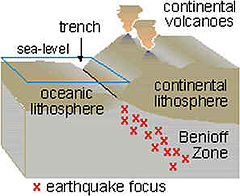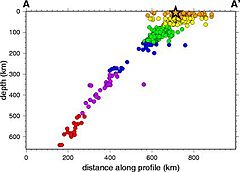Wadati-Benioff zone
In plate tectonics, a Wadati-Benioff zone (also Benioff-Wadati zone or Benioff zone or Benioff seismic zone) is a flat zone of seismicity corresponding to the sinking plate in a subduction zone along one side of an oceanic trench. The differential motion along the plane of friction between the two plates (Benioff plane) is where the foci or hypocenters of the numerous earthquakes that occur regularly are concentrated, whose foci can reach a depth of about 670 km and which are projected on the map on the internal side or concave of the arc drawn by the trench, that is, by the subduction line. This zone, in which earthquakes are frequent, is what is called the Benioff zone, who observed that the hypocenters occur at a greater depth the greater the distance from the trench. The term was named for the two seismologists, Hugo Benioff of the California Institute of Technology and Kiyoo Wadati of the Japan Meteorological Agency, who independently discovered the zones.
Earthquakes in the Wadati-Benioff zone occur beneath volcanic island arcs and continental slopes above active subduction zones. They can be caused by slip along subducting thrust fault or by sliding on faults within the downgoing plate, and as a result of flexing and extension of the plate, it is pulled into the mantle. Deep-focused earthquakes along the zone allow seismologists to map the three-dimensional surface of a subducted plate of oceanic crust and mantle.
Discovery
In 1949, American seismologist Hugo Benioff (1899-1968) introduced a method for determining the elastic rebound stress increments of earthquakes on a particular fault. He determined that the square root of an earthquake's energy is proportional to both the increase in elastic rebound stress and rebound displacement, and developed a way to determine whether a series of earthquakes were generated along a single fault structure. Their research focused on the Kermadec-Tonga subduction zone and the South American subduction zone, and determined that at both locations earthquake pockets fall along planes that dip ~45° from the trenches. These seismicity planes were later called Benioff zones, or Wadati-Benioff zones, after the Japanese seismologist Kiyoo Wadati (1902-1995), who made similar observations independent of Benioff at the same time.
Structure
The dip angle of the subducting plate, and therefore of the Benioff seismic zone, is dominated by the negative buoyancy of the plate and by the forces of flow from the asthenosphere. A younger lithosphere is hotter and more buoyant, giving rise to shallow-dipping Benioff zones, while an older lithosphere is denser and cooler, causing steeper dips. The Benioff zone spans from the near surface to depths of up to 670 km. The upper limit is just below the weak sediments, at the tip of the subduction zone wedge, and the lower limit is where the brittle-ductile transition occurs. Most earthquakes occur within the 1000 °C isotherm, in the interior of the plate that has not yet heated to match the temperature of the surrounding mantle into which it is subducting. At depths below the thickness of the lithosphere, earthquakes are no longer generated by thrust at the interface of the two plates, because the asthenosphere is weak and cannot withstand the stresses necessary to fail. In this region, the internal deformation of the still cold descending plate is the source of the earthquakes. Down to depths of 300 km, dehydration reactions and eclogite formation are the main causes of seismicity. Below 300 km, starting at approximately the 700 °C isotherm, a mineralogical phase change from olivine to spinel occurs, and this is believed to be the dominant earthquake mechanism of these very deep earthquakes. In summary, The earthquakes that characterize the area are of three types due to their mechanism:
- in the area closest to the pit, the seismic symbol reveals a distensive origin, which is interpreted as the effect of the cloaking of the liosphere when subduction begins;
- in the middle and longer part, the earthquakes are friction, and are due to the one that occurs between the two plates on the Benioff plane;
- the deepest earthquakes, from 300 to 700 km deep, and further away from the pit are supposed to result from a abrupt contraction of the subducing materials. It is attributed to a critical phase transition, in which materials adapt to pressure by suddenly adopting more compact crystalline structures without changing the chemical composition.
The inclination of the Benioff plane varies from one area to another, but the angle between the Benioff plane and the horizontal is usually less than 45°. The greater the Benioff angle, the greater the magnitude of the earthquakes that are generated. Likewise, when it comes to continental margins, the greater the angle of the Benioff plane, the greater the possibility of generating tsunamis. On the other hand, the greater the angle, the greater the earthquake necessary for the generation of tsunamis. Such is the case of the South American coast, from Chile in the south to Colombia in the north.
Double Benioff Zones
In some cases, subduction zones show two parallel surfaces of seismicity separated by tens of kilometers at intermediate depths (50–200 km). A prime example of this is found on Japan's largest island, Honshu, where the Wadati-Benioff zone is characterized by two well-defined lines of seismic foci, with a distance between each line of 30 to 40 km. A study of the global prevalence of double Benioff zones has found that they are common in zones of subduction around the world.
The highest surface seismicity is found in the crust of the descending plate and is attributed to dehydration reactions within that oceanic crust that result in the formation of eclogite. The mechanism behind the lower zone of seismicity, located in the upper mantle portion of the descending lithosphere, is still debated; the global ubiquity of double Benioff zones indicates that it must be a process that commonly occurs in subduction zones.. Some of the suggested mechanisms of instability include dehydration embrittlement caused by the breakdown of antigorite or chlorite in an upper mantle of hydrated peridotite, and non-flexing of the plate. Observations from seismic surveys indicate that the lithospheric mantle in the intermediate depths where the double Benioff zones occur it is dry, which favors the proposed mechanism for slab bending.
Contenido relacionado
Kingdom of Iberia
Watershed
Maracay

